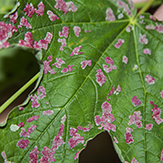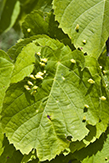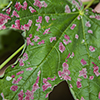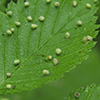Minnesota Mites and Ticks

Subclass Acari
Acari is the subclass of arachnids that includes mites and ticks. Acari are characterized by having an unsegmented abdomen and generally four pairs of unjointed legs.
There are about 50,000 known Acari species worldwide. There are at least 34 species of Acari, but certainly many more, in Minnesota. There are 13 species of ticks known to occur in Minnesota. Only 3 are commonly encountered by humans.
Recent Additions

At only one tenth the width of a human hair in length, a crimson erineum mite (Aceria elongata) is barely visible to the human eye unaided by magnification. Its claws, dorsal shield markings, and other identifying body features are not. Identification in the field is possible only by noting the properties of the abnormal growths (galls) it produces on its host.
Crimson erineum mite is a plant parasite infecting only sugar maple and possibly black maple. It is common in eastern United States and Canada. When injured by a mite, a leaf cell produces a small projection filled with colored fluid on the upper surface. Small patches of these are usually scattered over the leaf surface. They are greenish-white at first, soon becoming crimson or purplish. They reach their maximum extent, and are most noticeable, in summer. The infestation is sometimes abundant and can cause leaf distortion and premature leaf drop.

In Minnesota, this specialized plant feeder is found only on American basswood and littleleaf linden, usually the lower leaves. In other parts of the country it is also found on lime trees. As it feeds on the leaf it causes the host plant to create finger-like galls on the upper leaf surface. The galls are unsightly but the infestation causes no harm to the host tree. This is a common species yet little is known of its life cycle. The adult spends the winter in a crevice in the bark or near a bud. The first galls appear in June.
Other Recent Additions
This list includes only mites and ticks that have been recorded in Minnesota, but not all of the mites and ticks found in Minnesota.
| Profile | Photo | Video | |||
|---|---|---|---|---|---|
alder beadgall mite (Eriophyes laevis) |
|||||
alder leaf gall mite (Acalitus brevitarsus) |
|||||
ash flower gall mite (Aceria fraxiniflora) |
|||||
big bud mite (Phytoptus avellanae) |
|||||
black walnut petiole gall mite (Aceria caulis) |
|||||
brown dog tick (Rhipicephalus sanguineus) |
|||||
California black walnut petiole gall mite (Aceria brachytarsa) |
|||||
clover mite (Bryobia praetiosa) |
|||||
gall and rust mites (Family Eriophyidae) |
|||||
gall mite on sumac (Eriophyes rhoinus) |
|||||
hackberry witches’ broom mite (Eriophes celtis) |
|||||
ironwood leaf gall maker (Eriophyes spp.) |
|||||
lime felt gall mite (Eriophyes leiosoma) |
|||||
long-legged velvet mite (Leptus spp.) |
|||||
maple velvet erineum gall mite (Aceria aceris) |
|||||
oribatid mites (Galumna spp.) |
|||||
poison ivy leaf gall mite (Aculops rhois) |
|||||
poplar budgall mite (Aceria parapopuli) |
|||||
red grasshopper mite (Eutrombidium trigonum) |
|||||
sidewalk mites (Balaustium spp.) |
|||||
sumo mites (Allothrombium spp.) |
|||||
wheat curl mite (Aceria tulipae) |
|||||
willow bead gall mite (Aculus tetanothrix) |
|||||
winter tick (Dermacentor albipictus) |
|||||
witches’ broom (Eriophyes spp.) |
|||||
|
|||||
|
|||||
|
|||||
|
Acalitus brevitarsus (alder leaf gall mite)
Aceria aceris (maple velvet erineum gall mite)
Aceria brachytarsa (California black walnut petiole gall mite)
Aceria campestricola (elm leaf gall mite)
Aceria caulis (black walnut petiole gall mite)
Aceria elongata (crimson erineum mite)
Aceria fraxini (ash bead gall mite)
Aceria fraxiniflora (ash flower gall mite)
Aceria negundi (boxelder pouchgall mite)
Aceria parapopuli (poplar budgall mite)
Aceria parulmi (elm finger gall mite)
Aceria tulipae (wheat curl mite)
Aculops rhois (poison ivy leaf gall mite)
Aculus tetanothrix (willow bead gall mite)
Allothrombium spp. (sumo mites)
Balaustium spp. (sidewalk mites)
Bryobia praetiosa (clover mite)
Dermacentor albipictus (winter tick)
Dermacentor variabilis (American dog tick)
Eriophes celtis (hackberry witches’ broom mite)
Eriophyes cerasicrumena (black cherry leaf gall mite)
Eriophyes emarginatae (plum finger gall mite)
Eriophyes laevis (alder beadgall mite)
Eriophyes leiosoma (lime felt gall mite)
Eriophyes rhoinus (gall mite on sumac)
Eriophyes spp. (ironwood leaf gall maker)
Eriophyes spp. (witches’ broom)
Eriophyes tiliae (red nail gall mite)
Eriophyidae (gall and rust mites)
Eutrombidium trigonum (red grasshopper mite)
Galumna spp. (oribatid mites)
Ixodes scapularis (blacklegged tick)
Leptus spp. (long-legged velvet mite)
Phytoptus avellanae (big bud mite)
Rhipicephalus sanguineus (brown dog tick)
Trombidiidae (true velvet mite)
Trombidioidea (velvet mites and chiggers)
Trombidium spp. (red velvet mite)
No Species Page Yet?
If you do not see a linked page for a species in the list at left you can still upload a photo or video or report a sighting for that species. Click on one of the buttons below and type in the common name and/or scientific name of the species in your photo, video, or sighting. A new page will be created for that species featuring your contribution.
These buttons not working for you?
Simply email us at info@MinnesotaSeasons.com.
Capitalization of Common Names
The 1997 version of Common Names of Insects and Related Organisms, published by the Entomological Society of America (ESA), contains only 9 spider species. Two of those are placed in the wrong family and four are unrecognized common names. The inadequate coverage of arachnids by the ICZN spurred the American Arachnological Society (AAS) to develop their own list, Common Names of Arachnids. While the ESA has no rule or guideline that addresses capitalization of common names, the AAS does. Capital letters should not be used unless 1) the name begins a sentence, then the first letter of the name should be capitalized; or 2) the common name begins with a proper name, and that proper name begins with a capital letter (place name or person’s last name). MinnesotaSeasons.com will adhere to the convention adopted by AAS.




_01it.jpg)













_01t.jpg)
